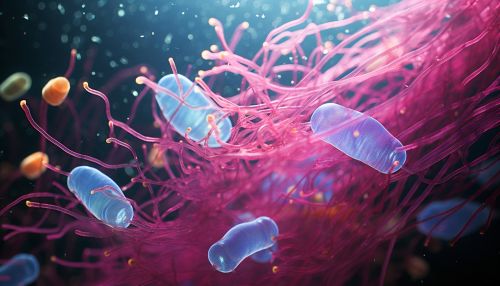Flagellar locomotion
Introduction
Flagellar locomotion is a mode of locomotion employed by certain microorganisms to move through their environment. This form of locomotion is facilitated by the presence of one or more whip-like appendages known as flagella. The flagella are long, slender, thread-like structures protruding from the cell body of the microorganism, and their coordinated, rhythmic movements propel the organism through its environment.


Structure of Flagella
Flagella are complex, highly specialized structures that are composed of several different types of proteins. The structure of a flagellum can be divided into three main parts: the basal body, the hook, and the filament.
Basal Body
The basal body is the part of the flagellum that is embedded within the cell membrane of the microorganism. It acts as the motor of the flagellum, providing the energy required for the rotation and movement of the flagellum. The basal body is composed of several protein rings that are anchored in the cell membrane and the cell wall.
Hook
The hook is a flexible joint that connects the basal body to the filament. It allows the filament to rotate and move in different directions, enabling the microorganism to navigate through its environment.
Filament
The filament is the longest part of the flagellum and extends out from the cell body. It is composed of a protein called flagellin, which is arranged in a helical manner to form a hollow tube. The filament is highly flexible, allowing it to whip and rotate, propelling the microorganism forward.
Mechanism of Flagellar Locomotion
Flagellar locomotion is achieved through the rotation of the flagella. The basal body acts as a motor, using the energy derived from the proton motive force to rotate the flagellum. This rotation propels the microorganism through its environment.
There are two main types of flagellar movement: running and tumbling. During the running phase, the flagella rotate in a counterclockwise direction, causing the microorganism to move forward in a straight line. During the tumbling phase, the flagella rotate in a clockwise direction, causing the microorganism to change direction.
Role of Flagellar Locomotion in Microorganisms
Flagellar locomotion plays a crucial role in the survival and proliferation of microorganisms. It allows them to navigate towards favorable environments and away from unfavorable ones, a behavior known as chemotaxis. For example, bacteria can move towards sources of nutrients or away from harmful substances.
In addition to chemotaxis, flagellar locomotion also plays a role in other behaviors such as phototaxis (movement towards or away from light), aerotaxis (movement towards or away from oxygen), and magnetotaxis (movement in response to magnetic fields).
Evolution of Flagella
The evolution of flagella is a topic of ongoing research and debate among scientists. Some scientists propose that flagella evolved from a type of secretory system known as the type III secretion system. Others suggest that flagella may have evolved from other cellular structures such as pili.
Despite the uncertainty surrounding the exact evolutionary origins of flagella, it is widely accepted that flagella have played a crucial role in the survival and success of microorganisms throughout evolutionary history.
